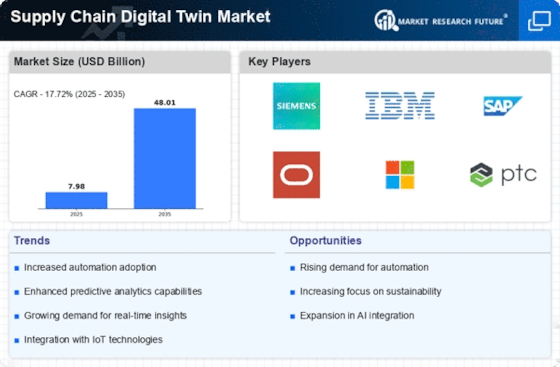Demand for Real-Time Analytics
The growing demand for real-time analytics is significantly influencing the Supply Chain Digital Twin Market. Organizations are increasingly recognizing the value of immediate insights derived from data, which can lead to more informed decision-making. Digital twins enable companies to simulate various scenarios and assess potential outcomes in real-time, thereby enhancing responsiveness to market changes. Research indicates that businesses leveraging real-time analytics can improve their operational efficiency by up to 30 percent. This trend is expected to drive the adoption of digital twin technologies, as firms seek to harness the power of data analytics to gain a competitive edge in their supply chains.
Integration of IoT Technologies
The integration of Internet of Things (IoT) technologies is a pivotal driver for the Supply Chain Digital Twin Market. IoT devices facilitate real-time data collection and monitoring, enabling organizations to create accurate digital representations of their supply chains. This integration allows for enhanced visibility and control over supply chain operations, which is crucial for optimizing performance. According to recent estimates, the IoT market in supply chain management is projected to reach USD 1 trillion by 2025, indicating a robust growth trajectory. As companies increasingly adopt IoT solutions, the demand for digital twins is likely to surge, as these technologies work synergistically to improve decision-making and operational efficiency.
Focus on Supply Chain Resilience
The emphasis on supply chain resilience is a key driver for the Supply Chain Digital Twin Market. Recent disruptions have highlighted the vulnerabilities within supply chains, prompting organizations to seek solutions that enhance their resilience. Digital twins allow companies to model various scenarios, enabling them to prepare for potential disruptions and develop contingency plans. This proactive approach is essential for maintaining continuity in operations. The market for supply chain resilience solutions is projected to expand, with a focus on technologies that support adaptive and flexible supply chain strategies. As businesses prioritize resilience, the adoption of digital twin technologies is likely to increase.
Advancements in Simulation Technologies
Advancements in simulation technologies are significantly shaping the Supply Chain Digital Twin Market. These technologies enable organizations to create detailed and dynamic models of their supply chains, facilitating better planning and execution. Enhanced simulation capabilities allow for the testing of various strategies and the evaluation of their impacts on supply chain performance. The simulation software market is expected to grow substantially, with projections indicating a rise to USD 10 billion by 2025. This growth reflects the increasing recognition of the value of simulation in optimizing supply chain operations. As organizations seek to leverage these advancements, the demand for digital twin solutions is likely to escalate.
Regulatory Compliance and Risk Management
Regulatory compliance and risk management are becoming increasingly critical in the Supply Chain Digital Twin Market. As regulations surrounding supply chain operations tighten, organizations are compelled to adopt technologies that ensure compliance and mitigate risks. Digital twins provide a comprehensive view of supply chain processes, allowing companies to identify potential compliance issues and address them proactively. The market for compliance management solutions is anticipated to grow significantly, with estimates suggesting a compound annual growth rate of over 15 percent through 2026. This growth underscores the necessity for digital twin technologies that can assist organizations in navigating complex regulatory landscapes while maintaining operational integrity.

















Leave a Comment